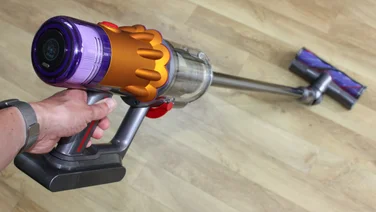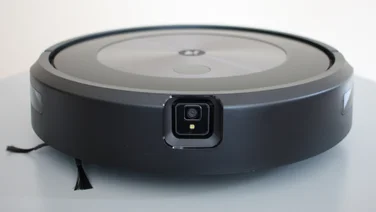To help us provide you with free impartial advice, we may earn a commission if you buy through links on our site. Learn more










- Good vacuum cleaning performance
- Set no-go areas during first run
- Physical spot clean button
- Basic mop
- Fiddly map management
On paper, the Lefant M1 robot vacuum cleaner ticks all the boxes of a modern robot vacuum. For £500, it combines vacuuming and mopping functions, and generates a modestly impressive 4,000Pa of suction. You might not get fashionable features such as self-emptying, but all the core essentials certainly appear to be in place.
Lefant M1 review: What do you get for the money?
The Lefant M1 doesn’t look particularly compact to the naked eye, but it’s actually slightly smaller than most rivals, with a diameter of 320mm and a height of 92mm (including its LiDAR turret). It’s about 20mm narrower than most rivals, letting it squeeze into smaller spaces.
It also isn’t as tall. All robots with LIDAR have a turret that rises out of the top so the laser can get a clear view of the walls and furniture around it. Generally, this type of robot doesn’t slide under my coffee table in the same way that turret-free robots can, but this one can. It’s still a tight fit and that doesn’t help it clean perfectly under there, but if you’re looking for the lowest-profile robot around that still uses LIDAR, this may well be it.
Considering its smaller size, the collection bin has a reasonable volume of 520ml. With no self emptying capabilities, however, it needs cleaning out regularly.
The suction of the vacuum is rated at 4,000Pa, which is twice the suction you get on the 2,000Pa Eufy RoboVac X8 for around the same price. Don’t assume this makes it twice as good, however. There’s more to a good clean than powerful suction.










There isn’t much in the box other than the robot itself. The charging station is relatively small in terms of the amount of space it takes up, being no taller than the robot, though it uses a ramp to charge the robot from underneath, rather than butting up to charge from the edge like some robots do. There are also a few consumables, with spare edge-sweeping brushes, a single washable mop cloth and three disposable cloths.
Lefant M1 review: What is it like to use?
There are three buttons on the Lefant M1: Start/stop cleaning, perform a spot clean or send it back to charge. You could more or less keep your house clean with these alone. Even the mopping function is activated by simply filling the tank with water and clipping on the mopping baseplate.
The inclusion of the spot clean button is a good one. I often find that robots that can be dropped and started directly on top of a mess have an advantage over robots that need driving into place, because they can collect a fair bit of a spillage before their wheels and brushes start disturbing it.










As usual, however, there’s a lot more functionality hidden in the app. The main screen shows you how much charge your robot has, and has a big button labelled ‘House cleaning’ that can be used to initiate a clean, much like the start/stop button on the robot itself. Tap on the on-screen robot, however, and you enter the secondary screen, which displays the map and provides a bank of further controls below it.
On the map you have options to: mark an area for a spot clean (which the app calls ‘Pointing and sweeping’), clean a particular area by dragging a rectangle around it, or set a no-go zone. The latter can be performed even while the robot is on its initial mapping run, which is good if you have cable nests and the like that you want it to avoid without having to clear them up first.
I wasn’t overly enamoured with the way spots and areas are selected, though. Most apps let you zoom into the map and drop a point by clicking on the screen, or an area by drawing or dragging a rectangle around it.
The Lefant app requires you to move an existing point or box into the correct position by dragging it, then adjusting the size of boxes in one corner, which proved more cumbersome than it ought to be. It was exacerbated by the app’s unwillingness to let you zoom in during this operation, which is nonsensical.
There are other foibles. By default, for example, the app wasn’t set to record and store maps – I had to find that option in the settings. It looks like there’s a way to store multiple maps, too, but during testing I struggled to get a second map of my upstairs areas saved for future reference. It’s great that the second map didn’t wipe the work I had put into marking-up the first one, but it would be good to control what’s going on when moving between floors more easily.










When a clean is finished, it’s down to you to empty the collection bin. This unclips from the back of the device, and the same release mechanism is used to free the lid. You can then tip its contents into a dustbin.
I found the powerful suction does a decent job of compacting the dust and debris, reducing the cloud of dust that appears during emptying. The filters can be removed and the collection bin rinsed with clean water, but the filters can only be tapped or brushed clean, not washed.
READ NEXT: Best floor cleaners
Lefant M1 review: Is it good at finding its way around?
With its turret-mounted LIDAR scanner, the Lefant M1 builds an accurate map of its surroundings as it travels around. As a result, its navigation is solid, with a sound concept that if it needs to get from A to B and there’s a wall separating them, it’s going to need to go around it.
It isn’t quite so clever with furniture. I found that it didn’t avoid leggy objects such as armchairs and occasional tables when passing through, but would instead charge straight through small gaps, even if it meant bumping into a chair and having to bounce around the legs a little to find a way through. This isn’t ideal, when an obvious clear path could have been charted with a little forethought.










It’s relatively gentle around skirting boards and furniture, using infrared to detect oncoming obstacles, rather than relying solely on its bumper. This works better with walls and solid obstacles than chair legs, though, as there’s still a reasonable amount of bumping done, albeit gently.
What it doesn’t do is detect dropped objects. I tried it with my usual trio of charging cable, discarded sock and joke shop dog poo, and it didn’t spot any of them. As a result, your floor needs to be cleared of such things before sending the robot out. If you want a robot that can do this, consider the iRobot Roomba j7.
Lefant M1 review: How well does it clean?
I tested the true mettle of the Lefant M1 by putting it through our battery of cleaning tests. For the vacuuming test, I tasked the robot with cleaning a series of spills on both short-pile carpet and hard floor.
Measured quantities of rice and flour are dropped on both types of surface, then the robot is physically placed onto the spillage and the spot clean button is pressed. By weighing the collection bin before and after each clean, I can measure how much of each spill is collected.
The big winner here was the rice collection. The powerful vacuum pulled up a lot of rice before the edge sweepers could scatter it. The Lefant then used a sensible expanding spiral pattern, to cover an area with a diameter of about 2m. Once it reached the edge, it turned around and repeated the spiral, this time circling in a decreasing pattern until it reached the middle.










In the rice test, the Lefant collected 96% of the spill from short-pile carpet, and 94% from hard floor, where scatter tends to be worse. This is above average across all our robot vacuum tests, and comes close to the results of the best robots we’ve tested of late, including the Ecovacs Deebot X1 Omni.

It didn’t fare quite as well with flour, though. It was just below average on the hard floor, collecting 80% of the spill, effectively leaving a circular dusting of flour behind. On carpet, it failed to lift the flour out of the pile, collecting only 38%, which is a disappointing result.
Switching to the mop is simple: fill the reservoir in the collection bin with water, then attach the mopping plate to the underside of the robot. I found it then took a few minutes of mopping before enough water had trickled through the system to properly dampen the cloth, which is a little annoying because it means the first pass won’t do anything.
Once the supplied washable cloth was sufficiently damp, however, it did a reasonable job of wiping some dried-on muddy paw prints from the hard floor in my kitchen. It took a couple of passes to tackle the dirtiest sections, and it doesn’t use any additional movement or friction beyond simply dragging the cloth behind it.
As is often the case with this kind of mop, it’s not as effective as the vacuuming. Problems arise because you need to manually ensure it isn’t going to travel over carpet, and make sure that the collection bin is emptied of water when the mop’s finished. If your dock is located on carpet, you will need to remove the mopping plate before it arrives. It’s probably best left to tackle the occasional gentle spot wash, rather than considering it a serious mop.
READ NEXT: Best hard floor cleaner
Lefant M1 review: Should I buy it?
The Lefant M1 does a lot right. The results of its vacuuming tests were good, and it can find its way around a single map with ease, so it could work well in a single storey home. It’s also relatively small and compact, particularly for a robot with a LIDAR turret, so it’s well suited to smaller spaces.
The app is mostly fine, but there is significant room for improvement – it doesn’t offer all the mapping features we would like, for starters. The multimap function is the most disappointing, as it’s vague and flaky about how multiple maps are saved, and it’s not possible to divide or label rooms, which can make partial cleans much easier on devices that do have these features.










Given these quibbles, I would lean towards the Eufy Robovac X8 instead. This model doesn’t mop your floor but has a brilliant app that makes it a more versatile and controllable robot vacuum, particularly if you want a robot that can handle multiple floors and be told to clean specific areas at different times.
For the best currently available robot vacuum and mop combo, you’ve got to splurge significantly more cash on the Ecovacs Deebot X1 Omni. This is an excellent self-emptying vacuum cleaner, and it has a good mopping action with pads that oscillate in different directions for extra agitation. It even cleans the pads for you when it’s finished, which is a lovely touch.







